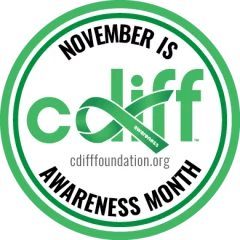
November is C.diff, Awareness Month and for a good reason. 29,300 people with C. diff infection die in the United States each year. One in 11 people over age 65 diagnosed with a healthcare-associated C. diff infection die within one month. What is C. diff? | CDC
C. diff is also known as Clostridioides difficile or C. difficile. This illness is a bacterium that causes an infection of the large intestine. Symptoms can range from diarrhea to life-threatening damage to the colon. Illness from C. diff typically occurs after use of antibiotic medications. It most commonly affects older adults in hospitals and long-term care facilities.
Our request for YOU – in honor of C.diff Awareness Month – is to review your C. diff rates, procedures and environmental cleaning practices.
Access the CDC Web site for Information targeted for healthcare clinicians; including diseases that result from C. diff, clinical symptoms, differences between colonization and isolation, transmission and treatment, steps to avoid C. diff and proper cleaning techniques.
Mild to moderate C.diff infection symptoms include watery diarrhea three or more times a day for more than one day and mild abdominal cramping and tenderness. Severe C. diff patients tend to become dehydrated and may need to be hospitalized; this can also cause the colon to become inflamed and form patches of raw tissue that can bleed or produce pus.
Besides using contact and isolation precautions and properly cleaning the environment, there are other ways to prevent C. diff. One of the most important is antibiotic stewardship. Antibiotic stewardship refers to programs and activities that promote the appropriate selection and use of antibiotics. Stewardship activities include limiting the use of antibiotics when they are not needed, minimizing frequency, duration, and number of antibiotics prescribed.
Attend the Antibiotic Stewardship: Updates and Opportunities to Reduce HAIs Webinar – on November 15, 2022. Details below.
 “When working in the hospital, I cared for many C. diff patients as well as a nurse colleague who was seriously ill with C. diff. She had developed C. diff after caring for a patient. She needed to be off work for a few weeks, lost a tremendous amount of weight and was terribly dehydrated. When I called to check on her, she continually repeated how awful she felt. That was not the last time that my nurse colleague developed C. diff. Each time after, if she needed to be on an antibiotic, she also developed C.diff.” – Tammy Wagner, RN, CADDCT, CDP, LSSGB; Great Plains QIN Quality Improvement Advisor.
“When working in the hospital, I cared for many C. diff patients as well as a nurse colleague who was seriously ill with C. diff. She had developed C. diff after caring for a patient. She needed to be off work for a few weeks, lost a tremendous amount of weight and was terribly dehydrated. When I called to check on her, she continually repeated how awful she felt. That was not the last time that my nurse colleague developed C. diff. Each time after, if she needed to be on an antibiotic, she also developed C.diff.” – Tammy Wagner, RN, CADDCT, CDP, LSSGB; Great Plains QIN Quality Improvement Advisor.
Antibiotic Stewardship: Updates and Opportunities to Reduce HAIs
November 15, 2022 | 3:00 – 4:00 p.m. CT
 Antibiotic resistance happens when microbes (germs) develop ways to survive the use of medicines meant to kill or weaken them. When bacteria develop resistance to antibiotics, it is much harder to treat infections that the bacteria cause. Antibiotic resistance is a growing problem in the U.S., and the main cause of this problem is the misuse of antibiotics.
Antibiotic resistance happens when microbes (germs) develop ways to survive the use of medicines meant to kill or weaken them. When bacteria develop resistance to antibiotics, it is much harder to treat infections that the bacteria cause. Antibiotic resistance is a growing problem in the U.S., and the main cause of this problem is the misuse of antibiotics.
In this Webinar, Josh Ohrtman, PharmD, will discuss antibiotic stewardship and the CDC’s core elements and explain why appropriate use of antibiotics is important. Ohrtman will also outline barriers to antibiotic stewardship and provide resources and opportunities for reducing healthcare-associated infections (HAIs).
Speaker: Josh Ohrtman, PharmD | Medicine Shoppe; Rapid City, SD
Patients & Families:
- What is C. diff and what symptoms to look for
- Who is at risk for C. diff infection
- How you can prevent the spread of C .diff in the hospital and at home
Healthcare Providers:
- The latest C.diff prevention guidance and resources
- NEW and UPDATED C. diff materials
- FREE print materials (search “C. diff” under “Programs”)
- Answers to frequently asked questions about C. diff

